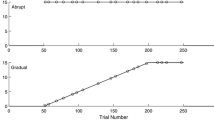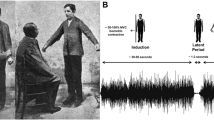Abstract
In control, stability captures the reproducibility of motions and the robustness to environmental and internal perturbations. This paper examines how stability can be evaluated in human movements, and possible mechanisms by which humans ensure stability. First, a measure of stability is introduced, which is simple to apply to human movements and corresponds to Lyapunov exponents. Its application to real data shows that it is able to distinguish effectively between stable and unstable dynamics. A computational model is then used to investigate stability in human arm movements, which takes into account motor output variability and computes the force to perform a task according to an inverse dynamics model. Simulation results suggest that even a large time delay does not affect movement stability as long as the reflex feedback is small relative to muscle elasticity. Simulations are also used to demonstrate that existing learning schemes, using a monotonic antisymmetric update law, cannot compensate for unstable dynamics. An impedance compensation algorithm is introduced to learn unstable dynamics, which produces similar adaptation responses to those found in experiments.
Similar content being viewed by others
References
Albus J (1971) A theory of cerebellar function. Math Biosci 10:25–61
Anderson BDO, Bitmead RR, Johnson CR, Kokotovic PV, Kosut R, Mareels IMY, Praly L, Riedle BD (1986) Stability of adaptive systems: averaging and passivity analysis. MIT, Boston, MA
Bhushan N, Shadmehr, R (1999) Computational nature of human adaptive control during learning of reaching movements in force fields. Biol Cybern 81:39–60
Burdet E, Codourey A, Rey L (1998) Experimental evaluation of nonlinear adaptive controllers. IEEE Control Syst Magazine 18(2):39–47
Burdet E, Milner TE (1998) Quantization of human motions and learning of accurate movements. Biol Cybern 78:307–318
Burdet E, Osu R, Franklin DW, Yoshioka T, Milner TE, Kawato M (2000) A method for measuring endpoint stiffness during multi-joint arm movements. J Biomech 33:1705–1709
Burdet E, Osu R, Franklin DW, Milner TE, Kawato M (2001) The central nervous system skillfully stabilizes unstable dynamics by learning optimal impedance. Nature 414:446–449
Burdet E, Franklin DW, Osu R, Tee KP, Kawato M, Milner TE (2004). How are internal models of unstable tasks formed? In: Proceedings of IEEE international conference on engineering in medicine and biology society. IEEE/EMB, San Francisco USA
Carter RR, Crago PE,Keith MW (1990) Stiffness regulation by reflex action in the normal human hand. J Neurophysiol 64:105–118
Colgate JE, Hogan N (1988) Robust control of dynamically interacting systems. Int J Control 48:65–88
De Wit CC, Siciliano B, Bastin G (1996). Theory of robot control. Springer, Berlin Heidelberg New York
Franklin DW, Burdet E, Osu R, Kawato M, Milner TE (2003A) Functional significance of stiffness in adaptation of multijoint arm movements to stable and unstable dynamics. Exp Brain Res 151:145–157
Franklin DW, Osu R, Burdet E, Kawato M, Milner TE (2003B) Adaptation to stable and unstable dynamics achieved by combined impedance control and inverse dynamics model. J Neurophysiol 90:3270–3282
Gomi H, Kawato M (1997). Human arm stiffness and equilibrium point trajectory during multi-joint movement. Biol Cybern 76:163–171
Gomi H, Osu R (1998). Task-dependent viscoelasticity of human multijoint arm and its spatial characteristics for interaction with environments. J Neurosci 18:8965–8978
Harris CM , Wolpert DM (1998) Signal-dependent noise determines motor planning. Nature 394:780–784
Hinder MR, Milner TE (2003) The case for an internal dynamics model versus equilibrium point control in human movement. J Physiol 549:953–963
Hodgson, AJ, Hogan N (2000) Model-independent definition of attractor behaviour applicable to interactive tasks. IEEE Trans Syst Man Cybern C. Appl Rev 30:105–118
Jacks A, Prochazka A, Trend PS (1988) Instability in human forearm movements studied with feed-back-controlled electrical stimulation of muscles. J Physiol 402:443–461
Katayama M, Kawato M (1993) Virtual trajectory and stiffness ellipse during multijoint arm movement predicted by neural inverse models. Biol Cybern 69:353-362
Kawato M, Furukawa K, Suzuki R (1987) A hierarchical neural-network model for control and learning of voluntary movement. Biol Cybern 57:169–185
Kawato M (1999) Internal models for motor control and trajecotry planning. Curr Opin Neurobiol 9:718–727
Krakauer JW, Ghilardi MF, Ghez C (1999) Independent learning of internal models for kinematic and dynamic control of reaching. Nat Neurosci 2:1026–1031
Lackner JR, Dizio P (1994) Rapid adaptation to Coriolis force perturbations of arm trajectory. J Neurophysiol 72:299–313
McIntyre J, Bizzi E (1993) Servo Hypotheses for the Biological Control of Movement. J Mot Behav 25:193–202
Milner TE (1993) Dependence of elbow viscoelastic behaviour on speed and loading in voluntary movements.Exp Brain Res 93:177–180
Milner TE, Cloutier C (1993) Compensation for mechanically unstable loading in voluntary wrist movement. Exp Brain Res 94:522–532
Milner TE, Franklin DW (2005) Impedance control and internal model use during the initial stage of adaptation to novel dynamics. J Physiol 567:651–664
Mirbagheri MM, Barbeau M, Kearney RE (2000) Intrinsic and reflex contributions to human ankle stiffness: variation with activation level and position. Exp Brain Res 135:423–436
Muramatsu E, Watanabe K (2003) Feedback error learning control of time delay systems. In: Proceedings of annual conference of the society of instrument and control engineers, Fukui, pp 312–317
Mussa-Ivaldi FA, Hogan N, Bizzi E (1985) Neural, mechanical, and geometric factors subserving arm posture in humans. J Neurosci 5: 2732–2743
Ostry DJ, Feldman AG (2003) A critical evaluation of the force control hypothesis in motor control. Exp Brain Res 221:275–288
Osu R, Burdet E, Franklin DW, Milner TE, Kawato M (2003) Different mechanisms involved in adaptation to stable and unstable dynamics. J Neurophysiol 90:3255–3269
Osu R, Kamimura N, Iwasaki H, Nakano E, Harris CM, Wada Y, Kawato M (2004): Optimal impedance control for task achievement in the presence of signal-dependent noise. J Neurophysiol 92:1199–1215
Perreault EJ, Kirsch RF, Crago PE (2002) Voluntary control of static endpoint stiffness during force regulation tasks. J Neurophysiol 87:2808–2816
Rancourt D, Hogan N (2001) Dynamics of pushing. J Mot Behav 33:351–362
Sanner RM, Kosha M (1999) A mathematical model of the adaptive control of human arm motions. Biol Cybern 80:369–382
Shadmehr R, Mussa-Ivaldi FA (1994) Adaptive representation of dynamics during learning of motor tasks. J Neurosci 14:3208–3224
Shadmehr R, Holcomb HH (1997) Neural correlates of motor memory consolidation. Science 277:821–825
Sinkjaer T, Toft E, Andreassen S, Hornemann BC (1988) Muscle stiffness in human ankle dorsiflexors: intrinsic and reflex components. J Neurophysiol 60:1110–1121
Slifkin AB, Newell KM (1999) Noise, information transmission, and force variability. J Exp Psychol Hum Percept Perform 25:837–851
Slotine JJE (1991) Applied nonlinear control. Prentice-Hall, Englewood Cliffs, NJ, USA
Tee KP, Burdet E, Chew CM, Milner TE (2004) A model of force and impedance in human arm movements. Biol Cybern 90:368–375
Won J, Hogan N (1995) Stability properties of human reaching movements. Exp Brain Res 107:125–136
Vidyasagar M (1993) Nonlinear systems analysis. Prentice Hall, Englewood Cliffs, NJ, USA
Author information
Authors and Affiliations
Corresponding author
Rights and permissions
About this article
Cite this article
Burdet, E., Tee, K.P., Mareels, I. et al. Stability and motor adaptation in human arm movements. Biol Cybern 94, 20–32 (2006). https://doi.org/10.1007/s00422-005-0025-9
Received:
Accepted:
Published:
Issue Date:
DOI: https://doi.org/10.1007/s00422-005-0025-9




